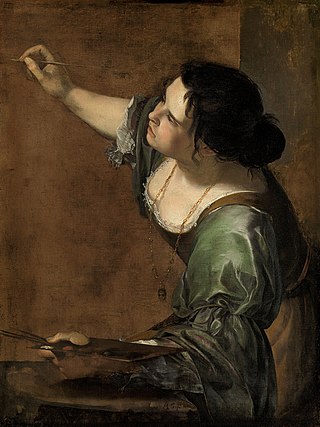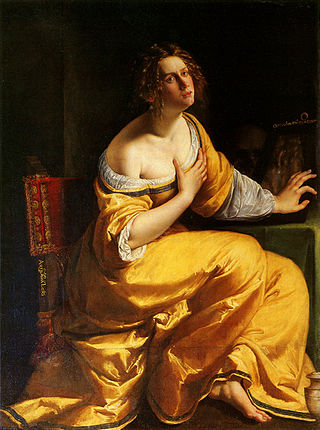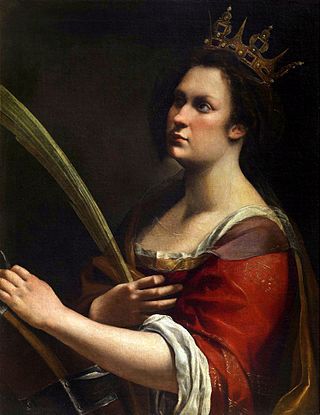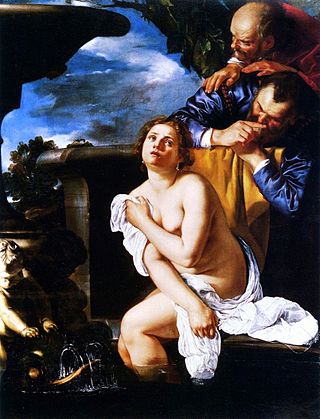
Artemisia Lomi or Artemisia Gentileschi was an Italian Baroque painter. Gentileschi is considered among the most accomplished seventeenth-century artists, initially working in the style of Caravaggio. She was producing professional work by the age of 15. In an era when women had few opportunities to pursue artistic training or work as professional artists, Gentileschi was the first woman to become a member of the Accademia di Arte del Disegno in Florence and she had an international clientele.

Elisabetta Sirani was an Italian Baroque painter and printmaker who died in unexplained circumstances at the age of 27. She was one of the first women artists in early modern Bologna, who established an academy for other women artists.

Giovanna Garzoni (1600–1670) was an Italian painter of the Baroque period. She began her career painting religious, mythological, and allegorical subjects but gained fame for her botanical subjects painted in tempera and watercolour. Her works were praised for their precision and balance and for the exactitude of the objects depicted. More recently, her paintings have been seen to have female bodily associations and proto-feminist sentiments. She combined objects very inventively, including Asian porcelain, exotic seashells, and botanical specimens. She was often called the Chaste Giovanna due to her vow to remain a virgin. Scholars have speculated Garzoni may have been influenced by fellow botanical painter Jacopo Ligozzi although details about Garzoni's training are unknown.

Judith Slaying Holofernes is a painting by the Italian early Baroque artist Artemisia Gentileschi, completed in 1612-13 and now at the Museo Capodimonte, Naples, Italy. The picture is considered one of her iconic works. The canvas shows Judith beheading Holofernes. The subject takes an episode from the apocryphal Book of Judith in the Old Testament, which recounts the assassination of the Assyrian general Holofernes by the Israelite heroine Judith. The painting shows the moment when Judith, helped by her maidservant Abra, beheads the general after he has fallen asleep in a drunken stupor. She painted a second version now in the Uffizi, Florence, somewhere between 1613 and 1621.

Self-Portrait as the Allegory of Painting, also known as Autoritratto in veste di Pittura or simply La Pittura, was painted by the Italian Baroque artist Artemisia Gentileschi. The oil-on-canvas painting measures 98.6 by 75.2 centimetres and was probably produced during Gentileschi's stay in England between 1638 and 1639. It was in the collection of Charles I and was returned to the Royal Collection at the Restoration (1660) and remains there. In 2015 it was put on display in the "Cumberland Gallery" in Hampton Court Palace.
Arcangela Paladini was an Italian painter, singer and poet.

Saint Apollonia is a painting attributed to the Italian baroque painter Artemisia Gentileschi executed between 1642 and 1644. It is part of the collection of the Museo Soumaya in Mexico City, Mexico.

Esther Before Ahasuerus is a painting by the 17th-century Italian artist Artemisia Gentileschi. It shows the biblical heroine Esther going before Ahasuerus to beg him to spare her people. The painting is now in the Metropolitan Museum of Art in New York, having been donated to the museum by Elinor Dorrance Ingersoll in 1969. It is one of Gentileschi's lesser known works, but her use of lighting, characterization, and style help in successfully portraying Esther as a biblical heroine as well as the main protagonist of the work.

Judith and her Maidservant is a c. 1615 painting by the Italian baroque artist Artemisia Gentileschi. The painting depicts Judith and her maidservant leaving the scene where they have just beheaded general Holofernes, whose head is in the basket carried by the maidservant. It hangs in the Pitti Palace, Florence.

Self-Portrait as a Lute Player is one of many self-portrait paintings made by the Italian baroque artist Artemisia Gentileschi. It was created between 1615 and 1617 for the Medici family in Florence. Today, it hangs in the Wadsworth Atheneum Museum of Art, Hartford, Connecticut, US. It shows the artist posing as a lute player looking directly at the audience. The painting has symbolism in the headscarf and outfit that portray Gentileschi in a costume that resembles a Romani woman. Self-Portrait as a Lute Player has been interpreted as Gentileschi portraying herself as a knowledgeable musician, a self portrayal as a prostitute, and as a fictive expression of one aspect of her identity.

Judith and Her Maidservant is one of four paintings by the Italian baroque artist Artemisia Gentileschi that depicts the biblical story of Judith and Holofernes. This particular work, executed in about 1623 to 1625, now hangs in the Detroit Institute of Arts. The narrative is taken from the deuterocanonical Book of Judith, in which Judith seduces and then murders the general Holofernes. This precise moment illustrates the maidservant Abra wrapping the severed head in a bag, moments after the murder, while Judith keeps watch. The other three paintings are now shown in the Museo di Capodimonte in Naples, the Palazzo Pitti in Florence, and the Musée de la Castre in Cannes.

Jael and Sisera is a painting by the Italian Baroque artist Artemisia Gentileschi, executed around 1620.

Pentinent Magdalene is a 1616–1618 painting by the Italian baroque artist Artemisia Gentileschi. This painting hangs in the Pitti Palace in Florence. The subject is the biblical figure Mary Magdalene, but the painting references another biblical woman, Mary, the sister of Lazarus. This painting was likely painted in Florence during Gentileschi's Florentine Period.

Saint Catherine of Alexandra is a painting by the Italian Baroque artist Artemisia Gentileschi. It is in the collection of the Uffizi, Florence. Gentileschi likely used the same cartoon or preparatory drawing to create both this painting and the Self-Portrait as Saint Catherine of Alexandria (1615–1617), now in the National Gallery, London.

Susanna and the Elders is a painting by the Italian artist Artemisia Gentileschi. It is signed with Gentileschi's name and the date of 1622. The painting is in the collection at Burghley House near Stamford, Lincolnshire, England.

Lucretia is a painting by the Italian baroque artist Artemisia Gentileschi. It depicts Lucretia, the wife of Roman consul and general Tarquinus, at the moment of her suicide. The decision to take her own life was made after she was blackmailed and raped by a fellow soldier of Tarquinus. It is one of a number of paintings of Gentileschi that focus on virtuous women ill-treated by men.

The Self Portrait of Italian baroque artist Artemisia Gentileschi was painted in the early 1630s. It currently hangs in the Palazzo Barberini, Rome. It is one of many paintings where Gentileschi depicts herself. Beyond self-portraits, her allegorical and religious paintings often featured herself in different guises.

Self-Portrait as Saint Catherine of Alexandria is a 1615–1617 painting by the Italian Baroque artist Artemisia Gentileschi, showing the artist in the guise of Catherine of Alexandria. It is now in the collection of the National Gallery, London, which purchased it in 2018 for £3.6 million, including about £2.7 million from its American Friends group.

Judith Slaying Holofernes c. 1620, now at the Uffizi Gallery in Florence, is the renowned painting by Baroque artist Artemisia Gentileschi depicting the assassination of Holofernes from the apocryphal Book of Judith. When compared to her earlier interpretation from Naples c. 1612, there are subtle but marked improvements to the composition and detailed elements of the work. These differences display the skill of a cultivated Baroque painter, with the adept use of chiaroscuro and realism to express the violent tension between Judith, Abra, and the dying Holofernes.
Allegory of Inclination is a 1615-1617 oil on canvas painting by Artemisia Gentileschi on the ceiling of the Galleria in the Casa Buonarroti, in Florence. The painting depicts a young nude female seated in the heavens holding a compass. Her light-colored hair is elaborately styled and she is partially covered by swirling drapery. A star appears above her head.

















